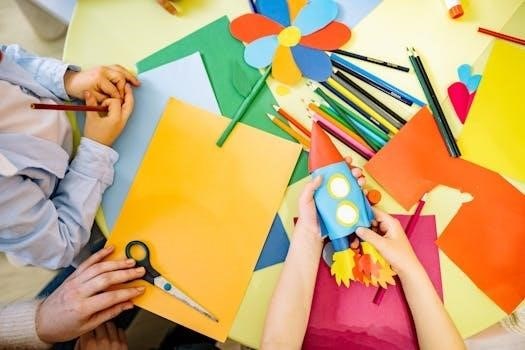What are Beginning Sounds Worksheets?
Beginning sounds worksheets are educational tools designed to help kindergarten students develop phonemic awareness․ These worksheets focus on identifying the initial sounds of words, linking letters to sounds, and building pre-reading skills in young learners․ They use pictures and letters
Definition and Purpose for Kindergarten
Beginning sounds worksheets are educational tools designed for kindergarten students to develop essential phonemic awareness and pre-reading skills․ These worksheets focus on helping children identify the initial sounds in words, linking letters to their corresponding sounds․ The purpose is to build a strong foundation in phonics, enabling young learners to decode words and improve reading readiness․ Activities often involve matching, tracing, and writing letters to enhance letter recognition and sound association․
Types of Beginning Sounds Worksheets
There are various beginning sounds worksheets, including matching activities, cut and paste worksheets, tracing exercises, and bingo dauber activities․ These formats help kindergarteners learn initial sounds in an engaging and interactive way․ Activities vary, so there is sure to be something for every child!
Matching Activities
Matching activities in beginning sounds worksheets involve connecting pictures to letters that represent their initial sounds․ These activities reinforce letter-sound correspondence, a crucial pre-reading skill․ Children draw lines between images and letters, enhancing their recognition of beginning sounds․ These worksheets often feature a variety of colorful pictures to keep young learners engaged, making the learning process fun and interactive․ Matching activities are an effective way to build phonemic awareness․
Cut and Paste Worksheets
Cut and paste worksheets are a hands-on approach to learning beginning sounds․ Children cut out letters or pictures and paste them onto corresponding images or letter boxes․ This tactile activity enhances fine motor skills while reinforcing phonemic awareness․ The interactive nature of cutting and pasting keeps students engaged, making learning fun․ These worksheets often include a variety of pictures and letters, providing ample opportunities for practice and skill development in identifying initial sounds in words․
Tracing and Writing Activities
Tracing and writing activities provide a crucial link between recognizing beginning sounds and forming letters․ These worksheets allow children to trace letters associated with specific initial sounds, reinforcing letter recognition․ Students then practice writing the letters independently, further solidifying their understanding․ This method not only improves handwriting skills but also strengthens the connection between auditory sounds and visual letter representation․ Incorporating pictures alongside tracing and writing helps to contextualize the letter-sound relationship, making it easier for kindergarteners to grasp the concept․
Bingo Dauber Worksheets
Bingo dauber worksheets offer a fun, interactive way for kindergarteners to practice identifying beginning sounds; These worksheets typically feature pictures, and students use bingo daubers to mark the letter that corresponds to the initial sound of each image․ This activity adds a tactile element to learning, making it more engaging for young children․ The use of bingo daubers also helps develop fine motor skills․ The visual and kinesthetic nature of this activity makes it particularly effective for reinforcing phonemic awareness and letter recognition in a playful manner․
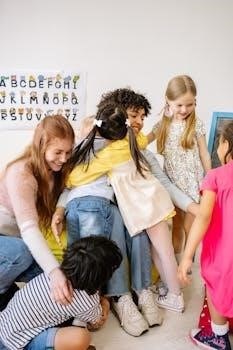
Skills Developed Through Beginning Sounds Worksheets
Beginning sounds worksheets enhance phonemic awareness, crucial for recognizing and manipulating sounds in words․ They also improve letter recognition, linking sounds to corresponding letters, and build pre-reading skills, setting a foundation for future literacy success in kindergarten․
Phonemic Awareness
Beginning sounds worksheets are pivotal in developing phonemic awareness in kindergarteners, the ability to hear and manipulate individual sounds in spoken words․ These worksheets provide targeted practice in isolating and identifying the first sound in a word, a crucial skill for decoding and reading․ By engaging with pictures and associating them with their initial sounds, children strengthen their phonemic awareness, a foundational element for reading success․ Activities like matching, tracing, and daubing further reinforce this essential skill, making learning interactive and effective․
Letter Recognition
Beginning sounds worksheets play a crucial role in fostering letter recognition skills among kindergarten students․ These worksheets present opportunities to associate letters with corresponding sounds, aiding in the memorization of the alphabet․ Through engaging activities such as matching letters to pictures representing initial sounds, children reinforce their understanding of letter forms and names․ By actively participating in exercises that require identifying and writing letters, students develop a strong foundation in letter recognition, which is essential for reading and writing proficiency․
Pre-Reading Skills
Beginning sounds worksheets are instrumental in developing essential pre-reading skills for kindergarteners․ These worksheets enhance phonemic awareness by focusing on initial sounds․ Children learn to connect sounds to letters, a foundational element for decoding words․ Activities involving matching, tracing, and writing build letter recognition and fine motor skills necessary for reading readiness․ By mastering the concept of beginning sounds, students gain confidence in their ability to approach reading tasks, setting them up for success in literacy development and comprehension․
How to Use Beginning Sounds Worksheets Effectively
To effectively use beginning sounds worksheets, integrate them into daily lesson plans․ Combine worksheets with hands-on activities and games to reinforce learning․ Use them as part of literacy centers, morning work, or as targeted intervention for students needing extra support․
Integrating into Lesson Plans
Integrating beginning sounds worksheets into lesson plans can significantly enhance early literacy skills․ Start by identifying specific phonemic awareness goals․ Incorporate the worksheets into daily routines, such as literacy centers or morning work․ Combine worksheet activities with interactive games, songs, and hands-on activities․ Use the worksheets to reinforce letter-sound correspondence and vocabulary․ Review previously learned sounds regularly․ This systematic approach helps children build a strong foundation in phonics and reading readiness, ensuring a fun and engaging learning experience․
Making it Fun and Engaging
To make beginning sounds worksheets fun and engaging, incorporate colorful images and interactive elements․ Use bingo daubers, crayons, or markers for activities․ Introduce cut-and-paste activities to add a tactile element․ Create games where children match pictures to their beginning sounds․ Integrate movement by having kids act out words․ Offer rewards or praise for completing tasks․ Vary the types of worksheets to keep children interested․ Encourage peer interaction and collaborative learning․ By turning learning into play, children will develop a positive attitude toward phonics and reading․
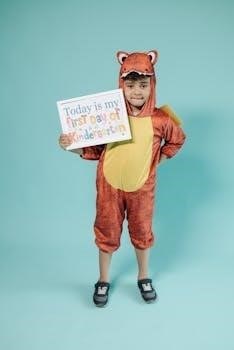
Free Printable Beginning Sounds Worksheets (PDF)
Numerous websites offer free, printable beginning sounds worksheets in PDF format․ These resources provide educators and parents accessible materials for phonics instruction․ Sites often feature a variety of activities to support early reading skills, all available for easy download․
Free Printable Beginning Sounds Worksheets (PDF)
Where to Find Them
Locating free printable beginning sounds worksheets in PDF format is quite simple, thanks to the abundance of online resources․ Websites dedicated to educational materials, teacher resources, and homeschooling often provide a variety of these worksheets․ You can also find them on blogs and platforms where educators share their creations․ Many of these sites offer direct downloads, making it easy to access and print the worksheets for classroom or home use, supporting early literacy development effectively․
Free Printable Beginning Sounds Worksheets (PDF)
How to Download and Print
Downloading and printing beginning sounds worksheets is a straightforward process․ First, locate a suitable website offering the worksheets in PDF format․ Click on the download link or button, which will save the file to your computer or device․ Once downloaded, open the PDF file using a PDF reader․ Then, select the print option, ensuring your printer is connected and has sufficient ink and paper․ Adjust print settings if needed, such as selecting “fit to page” to avoid cutoff․ Finally, click print to produce the worksheets for use․
Adapting Worksheets for Different Learning Styles
For visual learners, use colorful images and clear fonts on the beginning sounds worksheets․ Incorporate activities that involve matching pictures to letters or highlighting initial sounds․ This helps them connect visual cues with phonemic awareness effectively․
Visual Learners
To cater to visual learners, beginning sounds worksheets should incorporate vibrant colors and clear, easy-to-read fonts․ Include picture-matching activities where children connect images with corresponding letters․ Highlighting the initial sounds within words can also aid visual processing․ Worksheets that use distinct visual cues, such as color-coding or graphic organizers, help visual learners grasp phonemic awareness more effectively․ The use of printable alphabet bookmarks with pictures can be useful too․
Auditory Learners
For auditory learners, integrate verbal cues with beginning sounds worksheets․ Encourage students to say the words aloud while completing the activities․ Include exercises where children identify the beginning sound after hearing a word pronounced․ Use rhymes and songs to reinforce letter-sound relationships․ Incorporate activities that involve listening to and repeating initial sounds․ For example, you can ask students to say the name of each picture aloud, focusing on the first sound․
Kinesthetic Learners
For kinesthetic learners, use tactile materials alongside beginning sounds worksheets․ Provide letter manipulatives like magnetic letters or alphabet blocks․ Have students trace letters in sand or use playdough to form them․ Incorporate movement-based activities, such as acting out words that begin with specific sounds․ Use bingo daubers to mark the correct answers on the worksheets․ Cut and paste activities also provide a hands-on experience, enhancing learning for kinesthetic learners․
Beginning sounds worksheets align with Common Core standards for kindergarten, specifically focusing on phonological awareness․ They address standards like recognizing and producing rhyming words and isolating/pronouncing initial sounds in words․ These worksheets build a strong foundation for reading readiness skills․
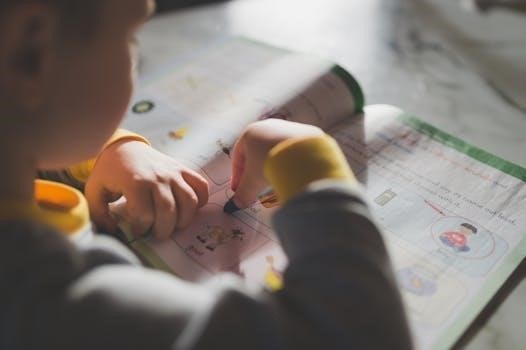
Common Core Standards Alignment
Relevant Standards for Kindergarten
Kindergarten Common Core standards relevant to beginning sounds worksheets include ELA-Literacy․RF․K․2․D, focusing on isolating and pronouncing the initial sounds (phonemes) in three-phoneme (CVC) words․ These worksheets support developing phonological awareness, a critical pre-reading skill․ Activities that help children identify the first sound in words align with these standards, building a strong foundation for future reading success and literacy development in early learners․ These standards ensure comprehensive phonics instruction․
Beginning sounds worksheets significantly improve reading readiness by helping children develop phonemic awareness․ By mastering initial sounds, children build a crucial foundation for decoding words․ This skill enhances their ability to sound out and read new words, boosting confidence in reading․
Improved Reading Readiness
Beginning sounds worksheets are instrumental in fostering improved reading readiness among kindergarten students․ These worksheets provide targeted practice in phonemic awareness, specifically focusing on the initial sounds of words․ By consistently engaging with these exercises, children begin to develop a strong connection between letters and sounds․ This foundational skill is essential for decoding words and ultimately enhances a child’s ability to read with greater fluency and confidence․ Regular practice contributes significantly to their overall reading development and sets the stage for future reading success․
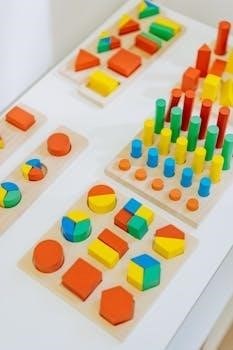
Benefits of Using Beginning Sounds Worksheets
Enhanced Vocabulary
Beginning sounds worksheets indirectly contribute to enhanced vocabulary in young learners․ As children work with these worksheets, they encounter a variety of words and pictures․ Recognizing the beginning sounds helps them to identify and remember new words․ This exposure, combined with visual aids, reinforces word recognition and strengthens their understanding of the relationship between sounds and meanings․ This early vocabulary building is crucial as it forms the bedrock for more advanced language skills and comprehension․ It also provides a solid foundation for future academic success in reading and writing․
Beyond Worksheets⁚ Other Activities for Learning Beginning Sounds
Learning beginning sounds can extend beyond worksheets through interactive games and activities․ Incorporate letter-sound matching games, use picture cards for identification, or create a “beginning sound” scavenger hunt․ These engaging methods reinforce learning in a fun, memorable way․
Games and Activities
Transform learning beginning sounds into an exciting adventure with interactive games! Try a “Beginning Sound Bingo” where children match pictures to letters․ Use picture cards for a “Go Fish” style game, focusing on initial sounds․ A “Sound Scavenger Hunt” encourages kids to find objects around the room that start with specific sounds․ These activities make learning fun and reinforce phonemic awareness in a playful, memorable way, complementing the skills learned from beginning sounds worksheets․ Incorporating movement and engagement is important!
